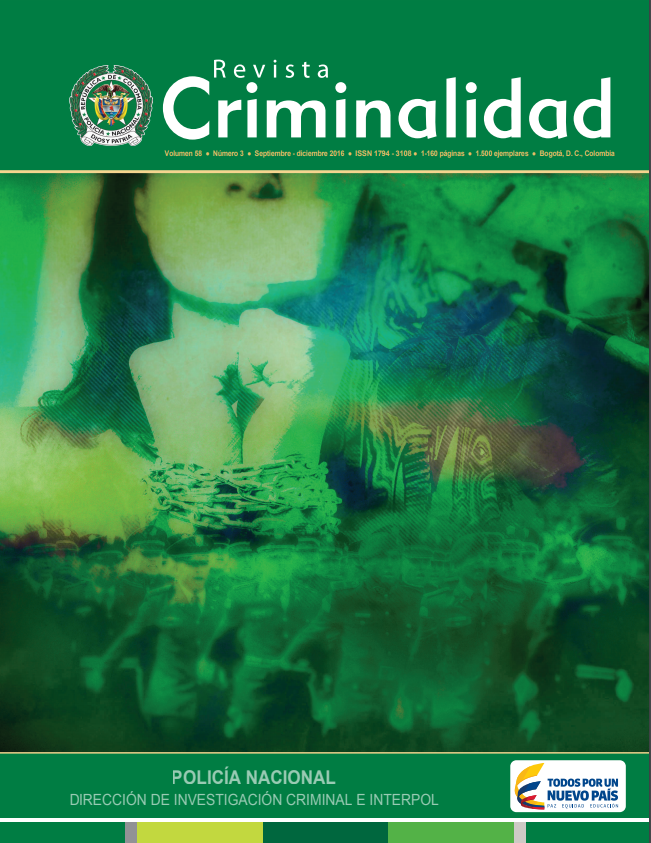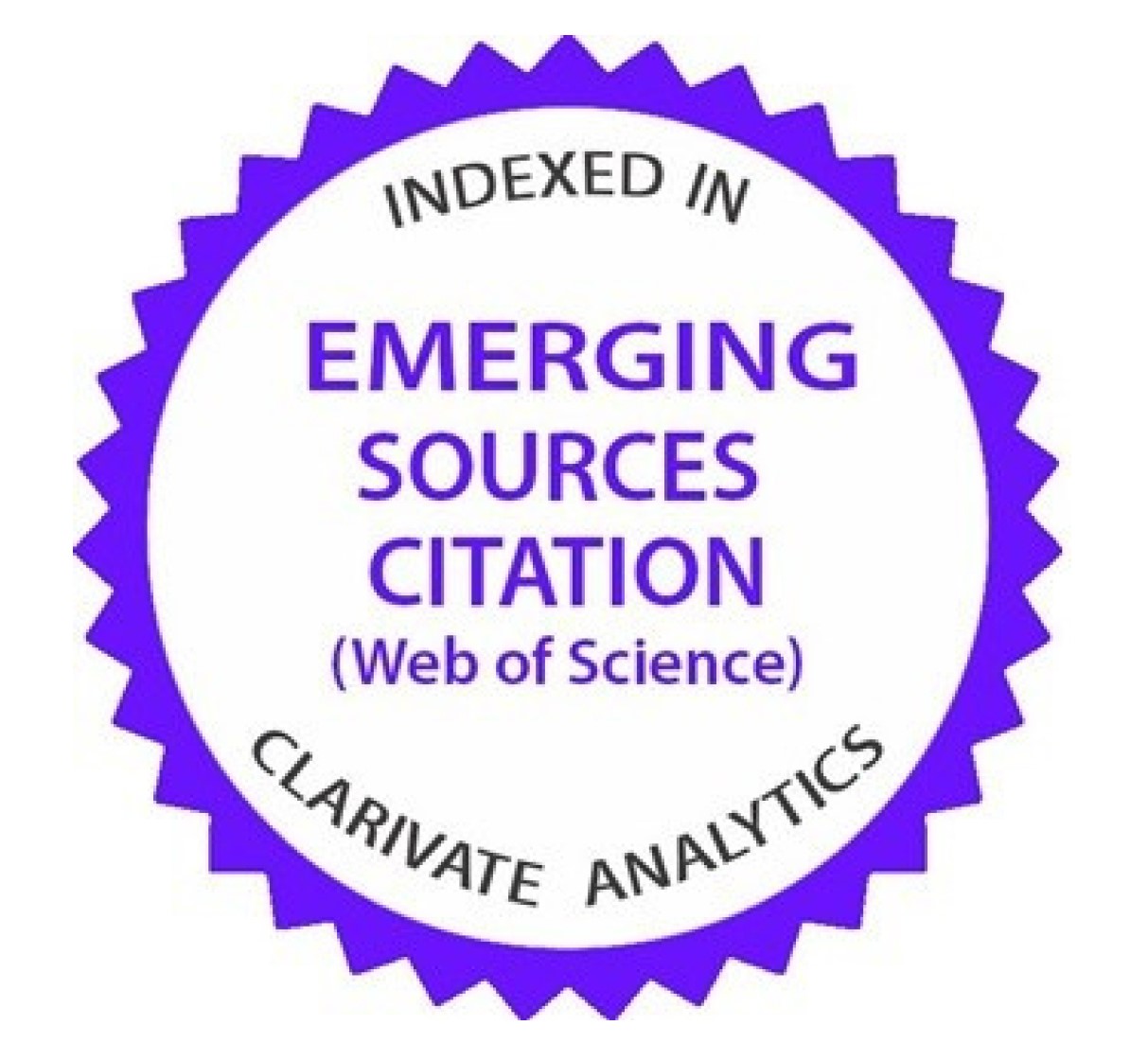Instrumentos para o valoração do risco da violência sexual em ofensores sexuais adolescentes: evidências da validez nos países de América Latina
DOI:
https://doi.org/10.47741/17943108.109Palavras-chave:
ofensores sexuais, jovens ofensores sexuais, avaliação do risco, predição da reincidência, tratamento de ofensores sexuaisResumo
Este artigo de revisão pretende conhecer a evidência da validez disponível, em América Latina, dos instrumentos principais no âmbito internacional para a valoração do risco de reincidência sexual em ofensores sexuais adolescentes. Para isso uma revisão bibliográfica descritiva foi feita, e palavras chaves compatíveis com a matéria analisada foram usadas, através dos bancos de dados ISI Web of Science e Scopus e do metabuscador Google Scholar. Os resultados destacam, como países principais na criação deste tipo de mecanismos, a Canadá e Estados Unidos, com ferramentas como J-SOAP-II, ERASOR 2.0, JSORRAT-II, J-RAT, MEGA e DASH-13. Também, constatase a falta de pesquisas que exploram as propriedades psicométricas destes instrumentos em América Latina, e a carência de indício em torno da construção daqueles de valoração do risco da violência sexual dentro desta zona geográfica. Discutem-se as implicâncias destes efeitos para a avaliação e a intervenção em ofensores sexuais adolescentes, e as dificuldades relativas ao uso excessivo do procedimento julgamento clínico reconhecido na valoração do risco e/ou o uso de ferramentas carentes das certezas da validez para esta população.
Downloads
Referências
Aebi, M., Plattner, B., Steinhausen, H. C. & Bessler, C. (2011). Predicting sexual and nonsexual recidivism in a consecutive sample of juveniles convicted of sexual offences. Sexual Abuse: A Journal of Research and Treatment, 23: 456-473. http://doi.org/10.1177/1079063210384634
Alarcón, P., Pérez-Luco, R., Wenger, L., Chesta, S., Lagos, L., Salvo, S. et al. (2014). Manual de evaluación diferenciada: Evaluar para intervenir (1st ed., Vol. 1). Temuco, Chile: Ediciones Universidad de La Frontera.
Álvarez, L. (2016). J-RAT v4: Juvenile Risk Assessment Tool. Versión traducida al español. Temuco, Chile: Autor.
Álvarez, L., Salazar, M. & Pérez-Luco, R. (2014). Desistence for Adolescents who Sexually Harm DASH-13. Versión traducida al español. Temuco, Chile: Autores.
Andrés-Pueyo, A. & Echeburúa, E. (2010). Valoración del riesgo de violencia: Instrumentos disponibles e indicaciones de aplicación. Psicothema, 22 (3): 403-409. Recuperado de http://www.psicothema.com
Andrés-Pueyo, A. & Redondo, S. (2007). Predicción de la violencia: Entre la peligrosidad y la valoración del riesgo de violencia. Papeles Del Psicólogo, 28 (3): 157-173. Recuperado de http://www.papelesdelpsicologo.es
Boer, D., Hart, S., Kropp, P. & Webster, C. (1997). Manual for the Sexual Violence Risk-20: Professional guidelines for assessing risk of sexual violence. Vancouver, Canadá: The Mental Health, Law, and Policy Institute.
Borum, R. (2003). Managing at-risk juvenile offenders in the community: Putting evidence based principles into practice. Journal of Contemporary Criminal Justice, 19: 114-137. http://doi.org/10.1177/1043986202239745
Calder, M., Hanks, H., Epps, K., Print, B., Morrison, T. & Henniker, J. (2001). Juveniles and children who sexually abuse: Frameworks for assessment (2nd ed.). Lyme Regis, UK: Russell House.
Caldwell, M. & Dickinson, C. (2009). Sex offender registration and recidivism risk in juvenile sexual offenders. Behavioral Sciences & the Law, 27: 941-956. http://doi.org/10.1002/bsl.907
Chávez, V. (2010). Is everyone rated equal? An examination of factors related to sexual risk in ethnically diverse male adolescents who have sexually offended. (Doctoral dissertation). Recuperado de http://digitalcommons.unl.edu/psychdiss/22/
Chu, C., Ng, K., Fong, J. & Teoh, J. (2012). Assessing youth who sexually offended: The predictive validity of the ERASOR, J-SOAP-II, and the YLS/CMI in a non-western context. Sexual Abuse: A Journal of Research and Treatment, 24: 153-174. http://doi.org/10.1177/1079063211404250
de Vries, M., de Vogel, V., Koster, K. & Bogaerts, S. (2015). Assessing protective factors for sexually violent offending with the SAPROF. Sexual Abuse: A Journal of Research and Treatment, 27: 51-70. http://doi.org/10.1177/1079063214550168
de Vries, M., Mann, R., Maruna, S. & Thornton, D. (2015). An exploration of protective factors supporting desistance from sexual offending. Sexual Abuse: A Journal of Research and Treatment, 27: 16-33. http://doi.org/10.1177/1079063214547582
Epperson, D. & Ralston, C. (2009). Validation of the Juvenile Sexual Offender Recidivism Risk Assessment Tool - II (JSORRAT-II) in Iowa. En 28th Annual Research and Treatment Conference of the Association for the Treatment of Sexual Offenders. Dallas, TX.
Epperson, D., Ralston, C. & Edwards, S. (2009). Juvenile Sexual Offense Recidivism Risk Assessment Tool-II (JSORRAT-II): Updated research on reliability and validity. En 13th Annual Research and Treatment Conference of the Association for the Treatment of Sexual Offenders. Brooklyn Park, MN.
Epperson, D., Ralston, C. & Fowers, D. (2009). Scoring guidelines for the Juvenile Sexual Offense Recidivism Risk Assessment Tool - II (JSORRAT- II). Pullman, WA: Washington Sate University.
Epperson, D., Ralston, C., Fowers, D. y De Witt, J. (2005). Development of a sexual offense recidivism risk assessment tool-II (JSORRAT-II). Unpublished manuscrip, University of Iowa, Ames
Fanniff, A. & Letourneau, E. (2012). Another piece of the puzzle: Psychometric properties of the J-SOAP-II. Sexual Abuse: A Journal of Research and Treatment, 24: 378-408. http://doi.org/10.1177/1079063211431842
Farrington, D. (1992). Criminal career research in the United Kingdom. British Journal of Criminology, 32 (4): 521-536. Recuperado de https://bjc.oxfordjournals.org/
Fortune, C. A. & Lambie, I. (2006). Sexually abusive youth: A review of recidivism studies and methodological issues for future research. Clinical Psychology Review, 26: 1078-1095. http://doi.org/10.1016/j.cpr.2005.12.007
Griffin, H. & Beech, A. (2004). Evaluation of the AIM framework for the assessment of adolescents who display sexually harmful behaviour. London, UK: Youth Justice Board for England and Wales.
Griffin, H., Beech, A., Print, B., Bradshaw, H. & Quayle, J. (2008). The development and initial testing of the AIM2 framework to assess risk and strengths in young people who sexually offend. Journal of Sexual Aggression, 14: 211-225. http://doi.org/10.1080/13552600802366593
Grisso, T. (1998). Forensic evaluation of juveniles. Sarasota, FL: Professional Resource Press.
Grubin, D. (1999). Actuarial and clinical assessment of risk in sex offenders. Journal of Interpersonal Violence, 14: 331-343. http://doi.org/10.1177/088626099014003007
Hanson, R. & Bussière, M. (1998). Predicting relapse: A meta-analysis of sexual offender recidivism studies. Journal of Consulting and Clinical Psychology, 66: 348-362. http://doi.org/10.1037/0022-006X.66.2.348
Hart, S. (2001). Assessing and managing violence risk. In K. Douglas, C. Webster, S. Hart, D. Eaves & J. Ogloff (Eds.), HCR-20: Violence risk management companion guide (pp. 13- 25). Burnaby: Mental Health, Law & Policy Institute.
Hart, S. (2009). Evidence-based assessment of risk for sexual violence. Chapman Journal of Criminal Justice, 1 (1): 143-165. Recuperado de https://www.chapman.edu
Hersant, J. (2006). Risk assessment of juvenile sex offender reoffense (Disertación doctoral no publicada). Southern Illinois University Carbondale, Carbondale, IL.
Klein, V., Rettenberger, M., Yoon, D., Köhler, N. & Briken, P. (2015). Protective factors and recidivism in accused juveniles who sexually offended. Sexual Abuse: A Journal of Research and Treatment, 27: 71-90. http://doi.org/10.1177/1079063214554958
Langton, C. & Worling, J. (2015). Introduction to the special issue on factors positively associated with desistance for adolescents and adults who have sexually offended. Sexual Abuse: A Journal of Research and Treatment, 27: 1-13. http://doi.org/10.1177/1079063214568423
Lay, B., Ihle, W., Esser, G. & Schmidt, M. (2005). Juvenile-episodic, continued or adultonset delinquency? Risk conditions analyzed in a cohort of children followed up to the age of 25 years. European Journal of Criminology, 2: 39-66. http://doi.org/10.1177/1477370805048629
Loeber, R., Farrington, D. & Redondo, S. (2011). La transición desde la delincuencia juvenil a la delincuencia adulta. Revista Española de Investigación Criminológica, 1 (9): 1-41. Recuperado de http://www.criminologia.net
Martínez, R., Flores, J. & Rosenfeld, B. (2007). Validity of the Juvenile Sex Offender Assessment Protocol - II (J-SOAP-II) in a sample of urban minority youth. Criminal Justice and Behavior, 34: 1284-1295. http://doi.org/10.1177/0093854807301791
McCoy, W. (2007). Predicting treatment outcome and recidivism among juvenile sex offenders: The utility of the JSOAP-II and ERASOR in an outpatient treatment program (Disertación doctoral no publicada). Sam Houston State University, Huntsville, TX.
Miccio-Fonseca, L. (2006). Multiplex Empirically Guided Inventory of Ecological Aggregates for Assessing Sexually Abusive Children and Adolescents (Ages 19 and Under)-MEGA. San Diego, CA: Autor.
Miccio-Fonseca, L. (2008). MEGA validated: The new face in risk assessment tools for sexually abusive female youth. En 11th Annual Training Conference of the California Coalition on Sexual Offending. San Francisco, CA.
Miccio-Fonseca, L. (2009). MEGA: A new paradigm in protocol assessing sexually abusive children and adolescents. Journal of Child & Adolescent Trauma, 2: 124-141. http://doi.org/10.1080/19361520902922434
Miccio-Fonseca, L. (2010). MEGA: An ecological risk assessment tool of risk and protective factors for assessing sexually abusive children and adolescents. Journal of Aggression, Maltreatment & Trauma, 19: 734-756. http://doi.org/10.1080/10926771.2010.515542
Miccio-Fonseca, L. & Rasmussen, L. (2013). Applicability of MEGA to sexually abusive youth with low intellectual functioning. Journal of Mental Health Research in Intellectual Disabilities, 6: 42-59. http://doi.org/10.1080/19315864.2011.650788
Miller, H. A. (2015). Protective strengths, risk, and recidivism in a sample of known sexual offenders. Sexual Abuse: A Journal of Research and Treatment, 27: 34-50. http://doi.org/10.1177/1079063214564389
Moffitt, T. (1993). Adolescence-limited and life-course-persistent antisocial behavior: A developmental taxonomy. Psychological Review, 100: 674-701. http://doi.org/10.1037/0033-295X.100.4.674
Morton, K. (2003). Psychometric properties of four risk assessment measures with male adolescent sex offenders (tesis de magíster no publicada). Carleton University, Ottawa, Ontario.
Nelson, R. (2012). Predicting recidivism among juvenile sex offenders: The validity of the ERASOR (tesis no publicada). Roger Williams Univeristy, Bristol, RI.
Pérez-Luco, R., Alarcón, P., Zambrano, A., Alarcón, M., Lagos, L., Wenger, L., Muñoz, J. & Reyes, A. (2014). Manual de intervención diferenciada: Prácticas que transforman vidas (1st ed., Vol. 1). Temuco, Chile: Ediciones Universidad de La Frontera.
Pérez-Luco, R., Lagos, L. & Báez, C. (2012). Reincidencia y desistimiento en adolescentes infractores: Análisis de trayectorias delictivas a partir de autorreporte de delitos, consumo de sustancias y juicio profesional. Universitas Psychologica, 11 (4): 1209-1225. Recuperado de http://revistas.javeriana.edu.co
Powers-Sawyer, A. & Miner, M. (2009). Actuarial prediction of juvenile recidivism: The static variables of the Juvenile Sex Offender Assessment Protocol-II (J-SOAP-II). Sexual Offender Treatment, 4 (2): 1-11. Recuperado de http://www.sexual-offender-treatment.org
Prentky, R., Harris, B., Frizzell, K. & Righthand, S. (2000). An actuarial procedure for assessing risk with juvenile sex offenders. Sexual Abuse: A Journal of Research and Treatment, 12: 71-93. http://doi.org/10.1177/107906320001200201
Prentky, R., Li, N. C., Righthand, S., Schuler, A., Cavanaugh, D. & Lee, A. (2010). Assessing risk of sexually abusive behavior among youth in a child welfare sample. Behavioral Sciences and the Law, 28: 24-45. http://doi.org/10.1002/bsl.920
Prentky, R. & Righthand, S. (2003). Juvenile Sex Offender Assessment Protocol-II (J-SOAP-II) Manual. Bridgewater, MA: Justice Resource Institute.
Rajlic, G. & Gretton, H. (2010). An examination of two sexual recidivism risk measures in adolescent offenders: The moderating effect of offender type. Criminal Justice and Behavior, 37: 1066-1085. http://doi.org/10.1177/0093854810376354
Ralston, C. & Epperson, D. (2012). Validation of the JSORRAT-II in Iowa: Update and expansion. En 31st Annual Research and Treatment Conference of the Association for the Treatment of Sexual Abusers. Denver, CO.
Redondo, S., Pérez, M., Martínez, M., Benedicto, C., Roncero, D. & León, M. (2012). Programa de tratamiento educativo y terapéutico para agresores sexuales juveniles. Madrid, España: Agencia de la Comunidad de Madrid para la Reeducación y Reinserción del Menor Infractor.
Rich, P. (2015). J-RAT: Juvenile Risk Assessment Tool. Barre, MA: Autor.
Salazar, M. & Pérez-Luco, R. (2016). Estimación de riesgo de reincidencia sexual en ofensores sexuales adolescentes chilenos: Características psicométricas de The Estimate of Risk of Adolescent Sexual Offense Recidivism ERASOR 2.0 (tesis no publicada). Magíster en Psicología Jurídica y Forense, Universidad de La Frontera, Temuco, Chile.
Singh, J., Condemarín, C. & Folino, J. (2013). El uso de instrumentos de evaluación de riesgo de violencia en Argentina y Chile. Revista Criminalidad, 55 (3): 279-290. Recuperado de http://www.policia.gov.co/portal/page/portal/HOME/publicaciones/revista_criminalidad/pub
Skowron, C. (2004). Differentiation and predictive factors in adolescent sexual offending. Carleton University, Ottawa, Canadá.
Spice, A., Viljoen, J., Latzman, N., Scalora, M. & Ullman, D. (2013). Risk and protective factors for recidivism among juveniles who have offended sexually. Sexual Abuse: A Journal of Research and Treatment, 25: 347-369. http://doi.org/10.1177/1079063212459086
Venegas, R., Sánchez, N., Hilterman, E. & S. Siria, S. (2013) Estimate of risk of adolescent sexual offender recidivism (ERASOR) Versión 2.0. (Traducción y adaptación de ERASOR 2.0 de James Worling y Tracey Curwen, 2001). Santiago, Chile: Autores.
Viljoen, J., Cruise, K., Nicholls, T., Desmarais, S. & Webster, C. (2012). Taking Stock and Taking Steps: The Case for an Adolescent Version of the Short-Assessment of Risk and Treatability. International Journal of Forensic Mental Health, 11 (3): 135-149. http://doi.org/10.1080/14999013.2012.737406
Viljoen, J., Elkovitch, N., Scalora, M. & Ullman, D. (2009). Assessment of reoffense risk in adolescents who have committed sexual offenses: Predictive validity of the ERASOR, PCL:YV, YLS/CMI, and Static-99. Criminal Justice and Behavior, 36: 981-1000. http://doi.org/10.1177/0093854809340991
Viljoen, J., Mordell, S. & Beneteau, J. (2012). Prediction of adolescent sexual reoffending: A meta-analysis of the J-SOAP-II, ERASOR, J-SORRAT-II, and Static-99. Law and Human Behavior, 36: 423-438. http://doi.org/10.1037/h0093938
Viljoen, J., Scalora, M., Cuadra, L., Bader, S., Chavez, V., Ullman, D. & Lawrence, L. (2008). Assessing risk for violence in adolescents who have sexually offended: A comparison of the J-SOAP-II, J-SORRAT-II, and SAVRY. Criminal Justice and Behavior, 35: 5-23. http://doi.org/10.1177/0093854807307521
Wenger, L. & Andrés-Pueyo, A. (2016). Tests forenses en espan~ol para evaluar adolescentes infractores. Papeles del Psicólogo, 37 (2): 107-117.
Worling, J. (2004). The Estimate of Risk of Adolescent Sexual Offense Recidivism (ERASOR): Preliminary psychometric data. Sexual Abuse: A Journal of Research and Treatment, 16: 235-254. http://doi.org/10.1023/B:SEBU.0000029135.53374.0d
Worling, J. (2013a). DASH-13: Desistence for Adolescents who Sexually Harm. Toronto, Canadá: Autor.
Worling, J. (2013b). What were we thinking? Five erroneous assumptions that have fueled specialized interventions for adolescents who have sexually offended. International Journal of Behavioral Consultation & Therapy, 8: 80-88. http://doi.org/10.1037/h0100988
Worling, J., Bookalam, D. & Litteljohn, A. (2012). Prospective validity of the Estimate of Risk of Adolescent Sexual Offense Recidivism (ERASOR). Sexual Abuse: A Journal of Research and Treatment, 24: 203-223. http://doi.org/10.1177/1079063211407080
Worling, J. & Curwen, T. (2000). Adolescent sexual offender recidivism: Success of specialized treatment and implications for risk prediction. Child Abuse and Neglect, 24: 965-982. http://doi.org/10.1016/S0145-2134(00)00147-2
Worling, J. & Curwen, T. (2001). The "ERASOR". Estimate of Risk of Adolescent Sexual Offense Recidivism. Version 2.0. In M. Calder, H. Hanks, K. Epps, B. Print, T. Morrison & J. Henniker (Eds.), Juveniles and children who sexually abuse: Frameworks for assessment (2nd ed., pp. 372-397). Toronto, Canadá: Russell House.
Worling, J. & Langton, C. (2015). A prospective investigation of factors that predict desistance from recidivism for adolescents who have sexually offended. Sexual Abuse: A Journal of Research and Treatment, 27: 127-142. http://doi.org/10.1177/1079063214549260
Zeng, G., Chu, C. & Lee, Y. (2015). Assessing protective factors of youth who sexually offended in Singapore: Preliminary evidence on the utility of the DASH-13 and the SAPROF. Sexual Abuse: A Journal of Research and Treatment, 27: 91-108. http://doi.org/10.1177/1079063214561684
Publicado
Como Citar
Edição
Seção
Licença
Licencia creative commons CC BY NC ND https://creativecommons.org/licenses/by-nc-nd/2.0/















